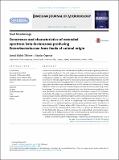DSpace Repository
Occurrence and characteristics of extended spectrum beta-lactamases-producing Enterobacteriaceae from foods of animal origin
- DSpace Home
- →
- Web Of Science
- →
- Web Of Science
- →
- View Item
JavaScript is disabled for your browser. Some features of this site may not work without it.
| dc.contributor.author | Tekiner, Ismail Hakki
|
|
| dc.date.accessioned | 2024-03-11T11:58:06Z | |
| dc.date.available | 2024-03-11T11:58:06Z | |
| dc.date.issued | 2016 | |
| dc.identifier.issn | 1517-8382 | |
| dc.identifier.issn | 1678-4405 | |
| dc.identifier.uri | http://hdl.handle.net/11547/11237 | |
| dc.description.abstract | Presence of extended spectrum beta-lactamases (ESBL) in bacteria is a growing health concern of global significance. The local, regional, national, and international epidemiological studies for extended spectrum beta-lactamases-producing Enterobacteriaceae and their encoding genes in foods are still incomplete. The objective of this study was to determine the occurrence of extended spectrum beta-lactamases-producing Enterobacteriaceae and the characteristics of their encoding genes from a total of 250 samples of various foods of animal origin (100 raw chicken meat, 100 raw cow milk, and 50 raw cow milk cheese) sold in Turkey. Overall, 55 isolates were positive as extended spectrum beta-lactamases-producing Enterobacteriaceae. The most prevalent extended spectrum beta-lactamases-producing strain were identified as Escherichia coli (80%), followed by Enterobacter cloacae (9.1%), Citrobacter braakii (5.5%), Klebsiella pneumoniae (3.6%), and Citrobacter werkmanii (1.8%) by Vitek (R) MS. The simultaneous production of extended spectrum beta-lactamases and AmpC was detected in five isolates (9.1%) in E. coli (80%) and E. cloacae (20%). The frequency rates of bla(TEM), bla(CTX-M), and bla(SHV) were 96.4%, 53.7%, and 34.5%, respectively. The co-existence of bla-genes was observed in 82% of extended spectrum beta-lactamases producers with a distribution of bla(TEM) & bla(CTX-M) (52.7%), bla(TEM) & bla(SHV) (20%), bla(TEM) & bla(CTX-M) & bla(SHV) (12.7%), and bla(SHV) & bla(CTX-M) (1.8%). The most prevalent variant of blacTx_m clusters was defined as bla(CTX-M-1) (97.2%), followed by bla(CTX-M-8) (2.8%). In summary, the analysed foods were found to be posing a health risk for Turkish consumers due to contamination by Enterobacteriaceae with a diversity of extended spectrum beta-lactamases encoding genes. (C) 2016 Sociedade Brasileira de Microbiologia. Published by Elsevier Editora Ltda. | tr_TR |
| dc.language.iso | en | tr_TR |
| dc.relation.ispartofseries | 47;2 | |
| dc.subject | ESBL-PRODUCING ENTEROBACTERIACEAE | tr_TR |
| dc.subject | ANTIBIOTIC-RESISTANCE MECHANISMS | tr_TR |
| dc.title | Occurrence and characteristics of extended spectrum beta-lactamases-producing Enterobacteriaceae from foods of animal origin | tr_TR |
| dc.type | Article | tr_TR |
Files in this item
This item appears in the following Collection(s)
-
Web Of Science [942]
